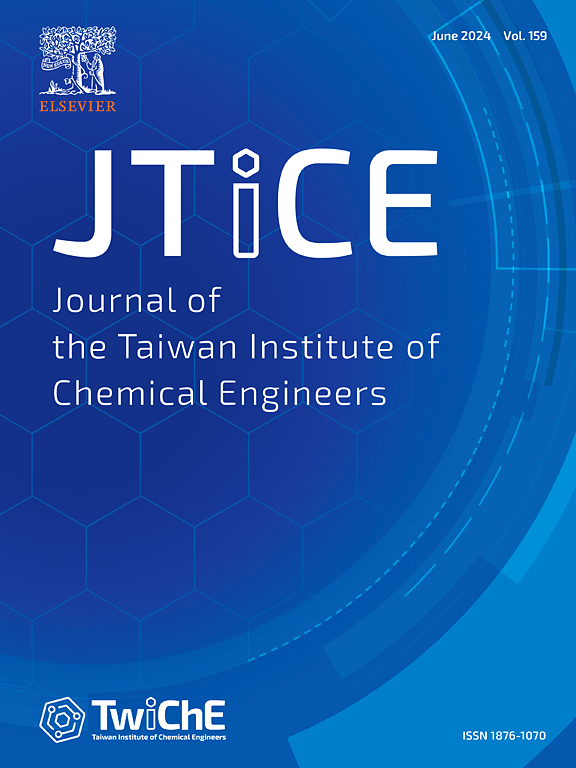莱茵衣藻CC400中碳酸酐酶异构体的自适应二氧化碳捕获
IF 6.3
3区 工程技术
Q1 ENGINEERING, CHEMICAL
Journal of the Taiwan Institute of Chemical Engineers
Pub Date : 2025-06-30
DOI:10.1016/j.jtice.2025.106258
引用次数: 0
摘要
化石燃料燃烧产生的二氧化碳排放量上升是气候变化的主要驱动因素,因此需要采取更可持续的减缓战略来减少大气中的碳排放。微藻由于其光合作用能力,有效地将CO 2转化为生物质,为碳捕获、储存和利用(CCUS)提供了可行的解决方案。方法利用内源线粒体CAH4过表达碳酸酐酶(CA)基因和转基因黄石硫氢酶(CHJS)基因改造莱因哈特衣藻CC400的碳捕集能力。酶和转录分析研究了基因CA在碳调控和重排中的作用。通过生物量、蛋白质、淀粉和脂质产量以及不同水平的CO 2捕获效率来评估CAH4和CHJS的影响,以评估菌株特定的碳同化趋势。显著发现表达内源性和外源性CAs可有效减少Rubisco维持,同时促进生物量积累。值得注意的是,这两个遗传菌株表现出明显的代谢偏好,在TAP培养基的混合营养条件下,淀粉产量达到0.64 g/L。在mBG11培养基自养培养下,蛋白质积累量最高,为0.38 g/L,突出了它们在条件依赖性碳利用方面的效率。改良菌株在碳吸收方面优于野生型CC400, CAH4在直接空气捕获条件下(0.04% CO₂)的效率提高了50%。相比之下,当CO₂浓度为1%和2%时,CHJS分别表现出10%和15%的中度增强。这些发现强调了在动态CO₂条件下,不同CAs在调节碳通量、优化代谢途径和改善碳固定方面的不同潜力。本文章由计算机程序翻译,如有差异,请以英文原文为准。

Rewiring carbonic anhydrase isoforms for adaptive carbon dioxide capture in Chlamydomonas reinhardtii CC400
Background
Rising CO₂ emissions from fossil fuel combustion are a major driver of climate change, necessitating more sustainable mitigation strategies to reduce atmospheric carbon release. Microalgae offer a viable solution for carbon capture, storage, and utilization (CCUS) due to their photosynthetic ability, efficiently converting CO₂ into biomass.
Methods
The carbon capture capability of Chlamydomonas reinhardtii CC400 was engineered by overexpressing carbonic anhydrase (CA) genes from endogenous mitochondrial CAH4 and a transgenic Sulfurihydrogenibium yellowstonense CA (CHJS). Enzymatic and transcriptional analyses were conducted to investigate the role of genetic CA in carbon regulation and rearrangement. The effects of CAH4 and CHJS were evaluated through biomass, protein, starch, and lipid production, along with CO₂ capture efficiency across varying levels to assess strain-specific carbon assimilation trends.
Significant findings
Overexpressing intrinsic and extrinsic CAs effectively minimized Rubisco maintenance while promoting biomass accumulation. Notably, both genetic strains displayed distinct metabolic preferences, with starch production reaching 0.64 g/L under mixotrophic conditions in TAP medium. Protein accumulation peaked at 0.38 g/L under autotrophic cultivation in mBG11 medium, highlighting their efficiency in condition-dependent carbon utilization. The modified strains outperformed wild-type CC400 in carbon uptake, with CAH4 achieving a 50 % efficiency increase under direct air capture conditions (0.04 % CO₂). In contrast, CHJS exhibited a moderate enhancement of 10 % and 15 % at CO₂ levels of 1 % and 2 %, respectively. These findings underscore the diverse potential of distinct CAs in modulating carbon flux, optimizing metabolic pathways, and improving carbon fixation under dynamic CO₂ conditions.
求助全文
通过发布文献求助,成功后即可免费获取论文全文。
去求助
来源期刊
CiteScore
9.10
自引率
14.00%
发文量
362
审稿时长
35 days
期刊介绍:
Journal of the Taiwan Institute of Chemical Engineers (formerly known as Journal of the Chinese Institute of Chemical Engineers) publishes original works, from fundamental principles to practical applications, in the broad field of chemical engineering with special focus on three aspects: Chemical and Biomolecular Science and Technology, Energy and Environmental Science and Technology, and Materials Science and Technology. Authors should choose for their manuscript an appropriate aspect section and a few related classifications when submitting to the journal online.

 求助内容:
求助内容: 应助结果提醒方式:
应助结果提醒方式:


